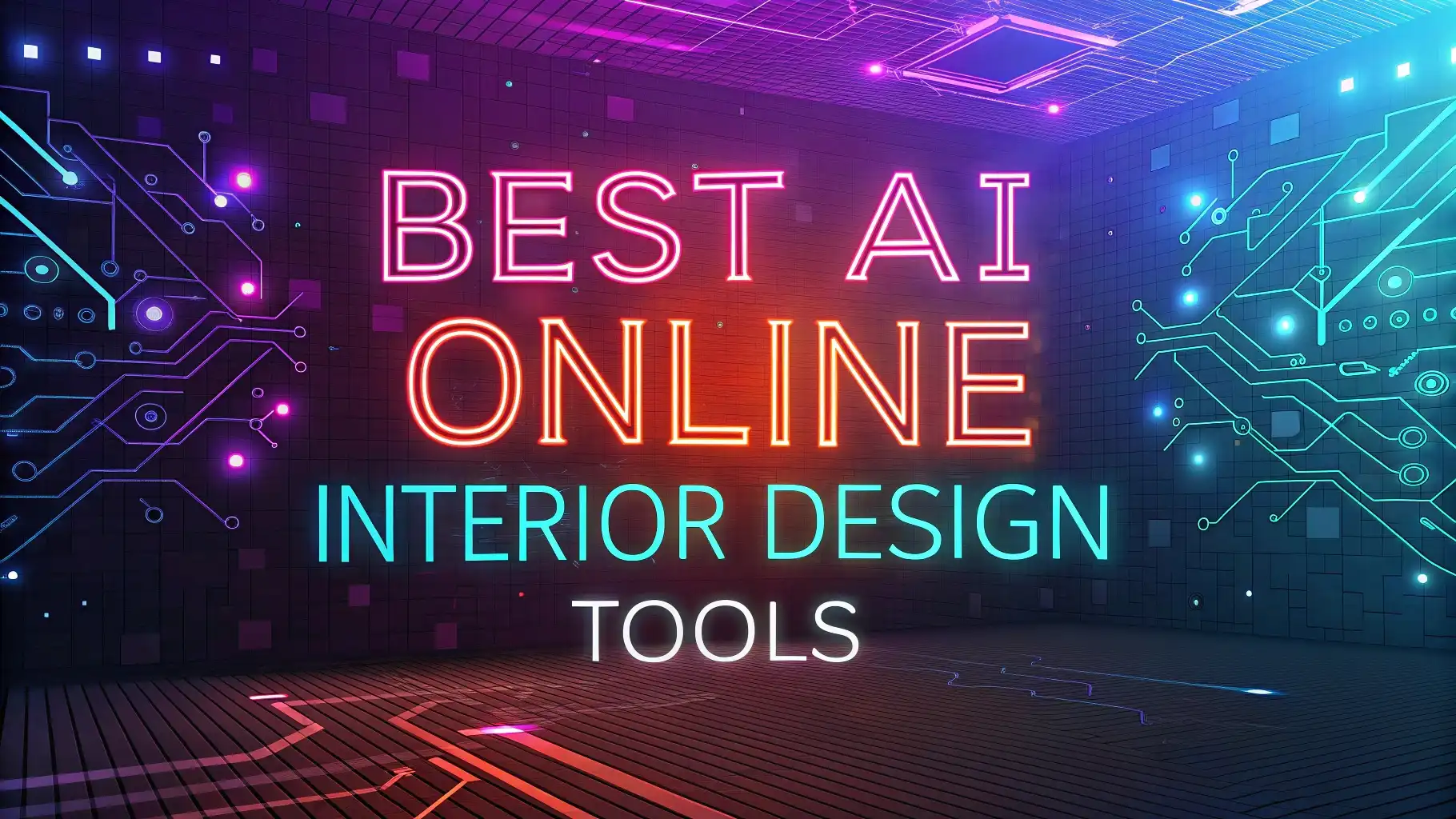3 Best AI Online Interior Design Tools: Redesign Home 2025
The interior design industry has experienced a remarkable transformation with artificial intelligence leading the charge. Gone are the days when creating stunning room designs required years of training or expensive consultant fees.
Today’s AI interior design tools have democratized home decoration, making professional quality designs accessible to everyone. The AI interior design market has grown exponentially, reaching $1.39 billion in 2025 with a compound annual growth rate of 27.3%.
Whether you are a homeowner looking to refresh your living space, a real estate professional needing virtual staging solutions, or simply someone curious about how your room could look with different styles, AI interior design tools offer instant, affordable, and surprisingly accurate results.
These revolutionary platforms can transform any space within seconds, providing multiple design options that would traditionally take hours or days to conceptualize.
Key Takeaways
- Instant Results: Upload a room photo and receive professional quality design suggestions within seconds, eliminating weeks of planning and conceptualization time
- Cost Effective Solution: Save thousands of dollars on interior design consultations while still achieving professional quality results for your home decoration projects
- Multiple Style Options: Explore various design aesthetics from modern minimalist to traditional cozy, allowing you to find the perfect match for your personal taste
- Real Estate Benefits: Virtual staging capabilities help property sellers showcase potential layouts, increasing buyer interest and potentially speeding up sales processes
- User Friendly Experience: These tools require no design experience or technical knowledge, making professional interior design accessible to everyone regardless of skill level
- Risk Free Experimentation: Test different furniture arrangements, color schemes, and decor styles before making expensive purchases or permanent changes to your space
Collov AI: The Complete Interior Design Solution
Collov AI stands out as one of the most comprehensive AI interior design platforms available today. This powerful tool specializes in transforming ordinary rooms into extraordinary spaces with remarkable speed and accuracy. The platform has gained recognition for its ability to generate photorealistic renderings that capture every intricate detail of proposed designs.
The standout feature of Collov AI is its versatility in handling different project types. Whether you need virtual staging for real estate listings, complete room redesigns for personal use, or quick visualization of specific design ideas, this platform delivers consistent, high quality results. The tool excels at maintaining architectural accuracy while introducing creative design elements.
Professional real estate agents particularly appreciate Collov AI for its virtual staging capabilities. The platform can take empty rooms and furnish them with appropriate, stylish furniture that appeals to potential buyers. This feature has proven invaluable for property marketing, helping listings stand out in competitive markets.
The user interface of Collov AI prioritizes simplicity without sacrificing functionality. Users can upload room photos, specify their preferred design style, and receive multiple design variations within seconds. The platform supports various design aesthetics, from contemporary minimalism to traditional elegance, ensuring there are options for every taste preference.
Collov AI also offers extensive customization options that allow users to fine tune generated designs. You can adjust color schemes, swap furniture pieces, modify lighting arrangements, and experiment with different decorative elements until you achieve the perfect look for your space.
RoomGPT: User Friendly Design Innovation
RoomGPT has established itself as one of the most accessible AI interior design tools, with over 2 million users worldwide appreciating its straightforward approach to room transformation. This platform combines the familiar chat based interaction model with powerful visual design capabilities, making it exceptionally easy for beginners to create professional looking room designs.
The simplicity of RoomGPT’s interface makes it ideal for first time users of AI design tools. The platform guides you through the design process step by step, explaining different style options and helping you understand how various elements work together to create cohesive room designs. This educational aspect sets it apart from more complex professional tools.
RoomGPT excels in generating semi realistic renderings that give you a clear sense of how different design choices will look in your actual space. While the results may not always achieve photographic realism, they provide excellent conceptual visualization that helps with decision making and planning.
The platform offers extensive style variety, including modern, minimalist, vintage, industrial, coastal, and many other popular design aesthetics. Users can select up to four different styles to see how their room would look with different design approaches, making it easy to compare options and find the perfect match.
Speed is another significant advantage of RoomGPT. The platform processes room photos and generates design suggestions remarkably quickly, allowing you to experiment with multiple concepts in a single session. This rapid iteration capability encourages creative exploration and helps users discover design possibilities they might not have considered otherwise.
Spacely AI: Professional Grade Visualization
Spacely AI represents the cutting edge of professional AI interior design technology, offering award winning rendering solutions that compete with traditional high end visualization services. This platform has gained recognition in the architecture and design industry for its ability to produce photorealistic renders that are virtually indistinguishable from professional photography.
The technical sophistication of Spacely AI sets it apart from simpler consumer focused tools. The platform uses advanced generative AI algorithms to create highly detailed, accurate visualizations that account for complex lighting conditions, material properties, and spatial relationships. This level of detail makes it particularly valuable for professional designers and architects.
Spacely AI excels in handling complex design scenarios that might challenge other AI tools. The platform can work with unusual room layouts, intricate architectural details, and sophisticated design requirements while maintaining accuracy and visual appeal. This capability makes it suitable for both residential and commercial design projects.
The platform offers comprehensive customization controls that allow users to fine tune every aspect of their designs. You can adjust lighting conditions, modify material finishes, experiment with different furniture arrangements, and even change architectural elements to see how they affect the overall design.
Professional users particularly appreciate Spacely AI’s integration capabilities with existing design workflows. The platform can work with architectural drawings, 3D models, and other professional design assets, making it a valuable addition to established design practices rather than a replacement for traditional methods.
Comparing Features and Capabilities
When evaluating these top AI interior design tools, several key factors distinguish their capabilities and suitability for different user needs. Each platform has developed unique strengths that make them more appropriate for specific types of projects and user skill levels.
Collov AI offers the best balance of features and accessibility, making it suitable for both casual users and professionals. Its virtual staging capabilities are particularly strong, while its general interior design features provide excellent results for personal home decoration projects. The platform strikes an optimal balance between ease of use and professional quality output.
RoomGPT focuses heavily on user experience and education, making it the ideal choice for beginners who want to learn about interior design while creating beautiful spaces. The platform’s chat based interface and extensive style options provide a comfortable entry point into AI assisted design, though the results may be less photorealistic than other platforms.
Spacely AI delivers the highest quality visualizations but requires more technical understanding to use effectively. Professional designers and architects will appreciate its advanced features and integration capabilities, while casual users might find the interface overwhelming compared to simpler alternatives.
Speed and processing time vary significantly between platforms. RoomGPT typically delivers the fastest results, making it perfect for quick experimentation. Collov AI offers good speed with higher quality output, while Spacely AI takes longer but produces the most detailed and accurate renderings.
Cost Analysis and Value Proposition
The pricing structures of AI interior design tools vary considerably, reflecting different target markets and feature sets. Understanding the cost implications helps users choose the most appropriate platform for their specific needs and budget constraints without overspending on unnecessary features.
Free options are available across all major platforms, though they typically come with limitations such as watermarked images, reduced resolution outputs, or restricted feature access. These free tiers provide excellent opportunities to test different platforms and determine which interface and style options work best for your projects.
Collov AI offers competitive pricing for its comprehensive feature set, with options for both casual users and professional applications. The platform’s pricing structure reflects its position as a premium service that delivers consistently high quality results across various project types.
RoomGPT provides excellent value for money, particularly for users who prioritize ease of use and quick results over maximum visual fidelity. The platform’s pricing makes it accessible to budget conscious users while still delivering useful design visualization capabilities.
Professional subscriptions and enterprise solutions are available for users who need advanced features such as high resolution downloads, commercial usage rights, or integration with existing design software. These options typically offer better per project pricing for users with regular design needs.
Getting Started with AI Interior Design
Beginning your journey with AI interior design tools requires minimal preparation, but following best practices will significantly improve your results. The key to success lies in understanding how to prepare your photos, communicate your preferences effectively, and interpret the generated designs constructively.
Photo preparation plays a crucial role in the quality of AI generated designs. Take clear, well lit photos that show the entire room from a good angle. Avoid extreme wide angle shots that distort proportions, and ensure that major architectural features such as windows, doors, and built in elements are clearly visible in your images.
Lighting conditions in your photos affect AI analysis, so try to photograph rooms during daylight hours when possible. If using artificial lighting, ensure it provides even illumination across the space. Dark or poorly lit photos may result in less accurate color suggestions and spatial understanding from the AI system.
Style communication varies between platforms but generally involves selecting from predefined categories such as modern, traditional, minimalist, or bohemian. Some platforms allow more detailed specification through text descriptions, while others rely primarily on visual style examples to guide the AI generation process.
Experimentation is key to getting the most value from these tools. Try multiple style options, experiment with different photo angles of the same room, and don’t hesitate to generate several variations of the same concept. This exploration process often reveals design possibilities you had not previously considered.
Understanding AI Interior Design Technology
Artificial intelligence has fundamentally changed how we approach interior design. These sophisticated tools use machine learning algorithms trained on millions of design images to understand spatial relationships, color harmonies, and style preferences. The technology analyzes your room’s architecture, lighting conditions, and existing elements to generate realistic design proposals that respect both aesthetic principles and practical constraints.
Modern AI design platforms process visual information much like a professional designer would, identifying key features such as windows, doors, architectural details, and existing furniture. The algorithms then apply design principles learned from thousands of successful interior projects to create cohesive, balanced room layouts that feel both fresh and livable.
The accuracy of these AI tools has improved dramatically over recent years. Current generation platforms can distinguish between different room types, understand spatial proportions, and even account for natural lighting patterns when suggesting color palettes and furniture arrangements. This level of sophistication means the designs you receive are not just visually appealing but also practically feasible.
What makes these tools particularly valuable is their ability to generate multiple design variations instantly. While a human designer might present two or three concepts after days of work, AI tools can show you dozens of different approaches in minutes, giving you a broader range of options to consider for your space transformation.
Benefits of Using AI for Interior Design
The advantages of AI interior design tools extend far beyond simple convenience. These platforms offer unprecedented speed and efficiency in the design process, allowing you to explore numerous concepts in the time it would traditionally take to schedule a single consultation with a professional designer.
Cost savings represent perhaps the most significant benefit for most users. Professional interior design services can cost thousands of dollars, while AI tools typically offer their services for free or at very affordable subscription rates. This democratization of design expertise means beautiful, well planned interiors are no longer limited to those with substantial budgets.
The experimental nature of AI design tools removes the fear factor from interior decoration decisions. You can try bold color combinations, experiment with different furniture styles, or test unconventional layouts without any financial commitment. This freedom to explore encourages more creative and personalized design choices.
Professional quality results are another major advantage. These AI systems have been trained on the work of top interior designers and can apply sophisticated design principles that might not be obvious to amateur decorators. The result is spaces that look professionally designed while reflecting your personal style preferences.
Real World Applications and Success Stories
AI interior design tools have found success across numerous real world applications, demonstrating their practical value beyond simple experimentation. Professional and personal users alike have discovered innovative ways to integrate these tools into their design and renovation processes.
Real estate professionals report significant benefits from using AI tools for virtual staging. Properties staged with AI generated furniture and decor often receive more online views and generate greater buyer interest compared to empty or poorly staged spaces. This application has proven particularly valuable in competitive housing markets.
Homeowners use these tools for renovation planning, experimenting with different design approaches before committing to expensive purchases or major changes. This preview capability has helped many people avoid costly design mistakes and has increased confidence in their decoration decisions.
Interior design professionals have integrated AI tools into their client consultation process, using them to quickly generate multiple design concepts for client review. This approach speeds up the initial design phase and helps clients visualize different options more clearly than traditional mood boards or sketches.
Small business owners, particularly those in hospitality industries, have used AI design tools to plan restaurant, café, and retail space layouts. The tools help visualize how different design choices will affect customer experience and business functionality before implementing expensive changes.
Advanced Features and Customization Options
Modern AI interior design platforms offer sophisticated customization capabilities that go well beyond simple style selection. Understanding these advanced features helps users create more personalized and accurate design visualizations that better reflect their specific needs and preferences.
Color palette customization allows users to specify preferred color schemes or restrict designs to certain color families. This feature proves particularly valuable when working with existing furniture or architectural elements that must be incorporated into new designs. Some platforms can analyze existing room colors and suggest complementary palettes.
Furniture style and price point specifications help generate designs that align with budget constraints and personal preferences. Users can specify whether they prefer vintage, contemporary, or mixed furniture styles, and some platforms can even suggest designs based on specified budget ranges.
Room function customization ensures generated designs serve practical purposes. Specifying whether a room will be used primarily for relaxation, entertainment, work, or other activities helps AI systems suggest appropriate furniture arrangements and design elements that support those functions.
Architectural constraint recognition in advanced platforms allows the AI to understand and work around structural limitations such as low ceilings, unusual room shapes, or permanent fixtures. This feature produces more realistic and implementable design suggestions.
Integration with Home Renovation Planning
AI interior design tools serve as valuable components of comprehensive home renovation planning, helping homeowners visualize potential changes before committing to expensive modifications. These platforms bridge the gap between imagination and reality, providing concrete visual references for renovation projects.
Budget planning benefits significantly from AI design visualization. By seeing realistic representations of different design approaches, homeowners can better understand the scope and cost implications of various renovation options. This foresight helps prevent budget overruns and ensures renovation investments align with desired outcomes.
Contractor communication improves when homeowners can show specific visual examples of their desired results. AI generated designs provide clear reference points for discussions with contractors, reducing misunderstandings and ensuring that renovation work meets expectations.
Phased renovation planning becomes more manageable with AI visualization tools. Homeowners can see how different phases of a renovation project will look, helping them plan the sequence of work and understand how each phase contributes to the final result.
Material and finish selection is simplified when AI tools can show how different options will look in context. This capability helps homeowners make confident decisions about flooring, paint colors, fixtures, and other elements that significantly impact the final appearance of renovated spaces.
Common Challenges and Solutions
While AI interior design tools offer remarkable capabilities, users often encounter specific challenges that can affect their experience and results. Understanding these common issues and their solutions helps users get better outcomes from their AI design experiments.
Photo quality issues represent the most frequent challenge users face. Blurry, dark, or distorted photos produce less accurate AI analysis and inferior design suggestions. The solution involves taking multiple clear photos from different angles and selecting the best ones for AI processing.
Style interpretation can sometimes differ from user expectations. AI systems may emphasize certain aspects of a design style while de emphasizing others, leading to results that feel inconsistent with the user’s vision. Experimenting with different style keywords or combinations often resolves this issue.
Spatial accuracy occasionally presents challenges, particularly in rooms with unusual layouts or proportions. AI systems trained primarily on standard room configurations may struggle with unique spaces. Taking photos that clearly show spatial relationships and room boundaries helps improve accuracy.
Furniture scale and proportion issues sometimes occur when AI systems misinterpret room dimensions from photos. This challenge often resolves by ensuring photos are taken from eye level and include reference objects that help the AI understand scale properly.
Future Trends in AI Interior Design
The AI interior design industry continues evolving rapidly, with several emerging trends likely to shape the future of these tools and their capabilities. Understanding these developments helps users anticipate new features and opportunities in the coming years.
Integration with augmented reality technology promises to make design visualization even more immersive and accurate. Future AI tools may allow users to see proposed designs overlaid on their actual rooms through smartphone cameras or AR glasses, providing unprecedented visualization accuracy.
Personalization algorithms are becoming more sophisticated, learning from user preferences and feedback to provide increasingly tailored design suggestions. These systems will eventually understand individual style preferences well enough to generate highly personalized designs with minimal input.
Sustainability and eco friendly design features are being integrated into AI platforms, reflecting growing environmental consciousness among consumers. Future tools may prioritize sustainable materials, energy efficient layouts, and environmentally responsible design choices.
Professional integration continues advancing, with AI tools becoming more compatible with traditional design software and workflows. This trend will likely lead to hybrid approaches that combine AI efficiency with human creativity and expertise.
Making the Most of Your AI Design Experience
Maximizing the value of AI interior design tools requires strategic approach and realistic expectations. These platforms work best when users understand their capabilities and limitations while approaching the design process with creativity and openness to unexpected possibilities.
Start with clear goals but remain flexible about implementation. AI tools excel at suggesting alternatives you might not have considered, so being open to unexpected design directions often leads to better results than rigidly following preconceived plans.
Use multiple platforms for comparison when working on important projects. Different AI systems have varying strengths, and comparing results from several tools provides a broader range of design options and helps identify the most promising approaches.
Document your favorite results and the settings or inputs that produced them. This practice helps you recreate successful design approaches for future projects and builds your understanding of how different inputs affect AI generated results.
Combine AI suggestions with personal creativity rather than following generated designs exactly. Use AI output as inspiration and starting points for further development, incorporating your personal preferences and practical requirements into the final design decisions.
Frequently Asked Questions
Are AI interior design tools suitable for professional use?
Yes, many AI interior design tools offer professional grade features suitable for commercial applications. Platforms like Spacely AI and Collov AI provide high resolution outputs, commercial usage rights, and integration capabilities that meet professional standards. However, they work best as supplements to traditional design skills rather than complete replacements for professional expertise.
How accurate are AI generated room designs compared to reality?
AI generated designs typically achieve good conceptual accuracy, showing realistic proportions, appropriate color schemes, and functional furniture arrangements. However, exact material textures, lighting conditions, and fine details may vary from reality. The designs serve best as visualization tools and inspiration rather than precise implementation guides.
Can AI tools work with unusual room shapes or architectural features?
Most modern AI interior design tools can handle non standard room layouts, though results may be less accurate than with typical rectangular rooms. Taking multiple photos from different angles and ensuring architectural features are clearly visible helps AI systems better understand and work with unusual spatial configurations.
What photo quality is needed for best AI design results?
Clear, well lit photos taken at eye level produce the best AI analysis results. Images should show the entire room without extreme wide angle distortion, include good lighting that reveals colors and textures accurately, and capture major architectural features like windows, doors, and built in elements clearly.
Are there any privacy concerns with uploading room photos to AI platforms?
Reputable AI interior design platforms typically include privacy policies that protect user uploaded images. However, users should review terms of service and privacy policies before uploading photos, particularly if images contain personal or sensitive information. Some platforms offer options to delete uploaded content after processing.
How much do AI interior design tools typically cost?
Pricing varies significantly between platforms and usage levels. Many tools offer free tiers with basic features, while premium subscriptions range from $5 to $50 per month depending on features and usage limits. Professional or commercial licenses may cost more but offer additional capabilities and usage rights suitable for business applications.

Leo Donovan is a passionate tech enthusiast and writer with a knack for making complex concepts accessible to all. With years of experience exploring the ever-evolving world of technology, Leo specializes in delivering practical advice, insightful AI tool reviews, and hands-on guides. When not diving into the latest gadgets or coding experiments, Leo enjoys sharing knowledge to empower others on their tech journey through How to Tech Info.







